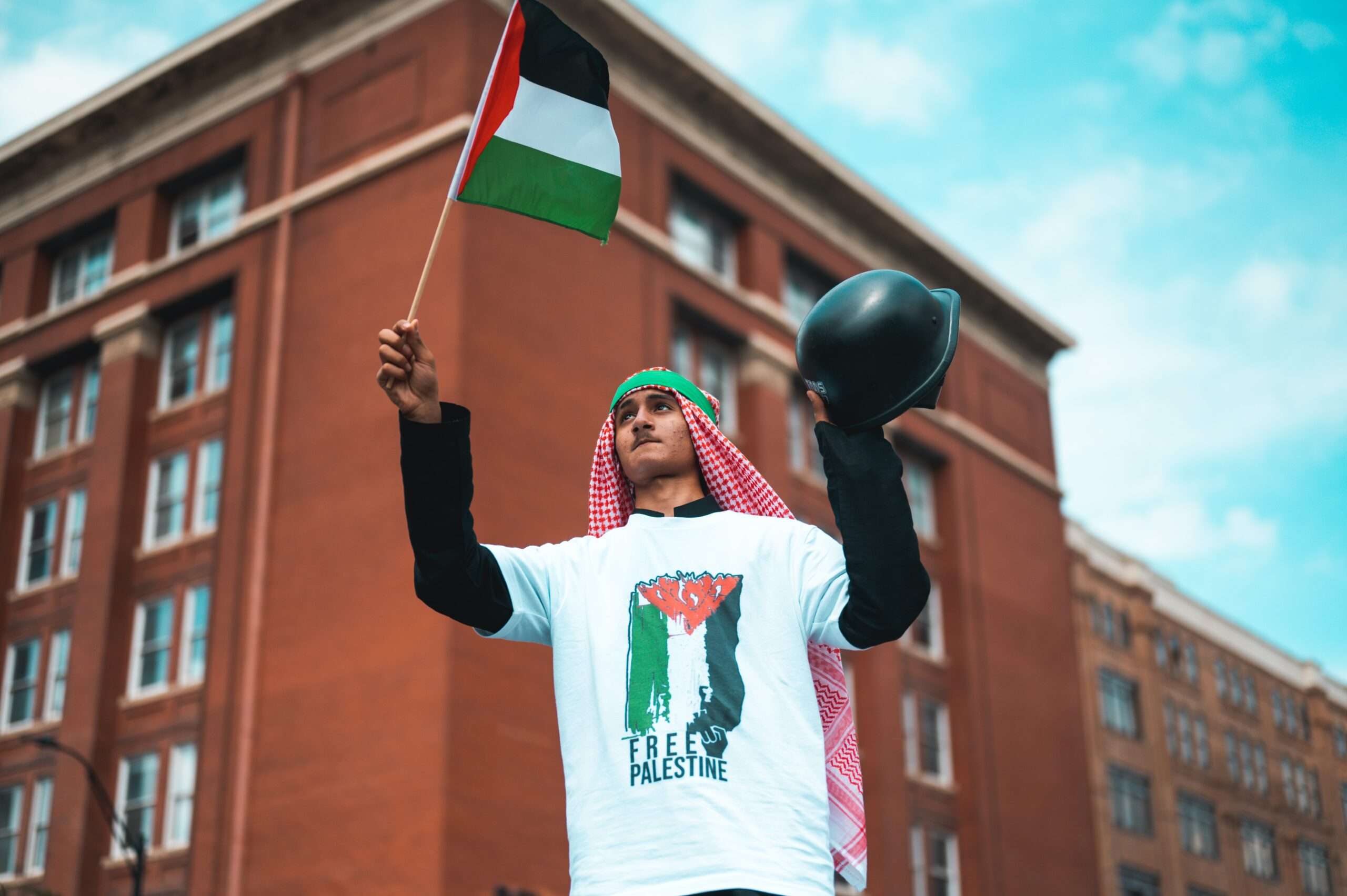There’s no other flag in the world quite like the Palestinian flag. In addition to being aesthetically pleasing, this design is steeped in symbolism and history. It was adopted by the Palestine Liberation Organization (PLO) on 28 May 1964 and has a tricolour consisting of three equal horizontal stripes (black, white, and green from top to bottom) overlaid by a red triangle issuing from the hoist side. The colours were chosen to represent hope, freedom and courage as well as standing in solidarity with oppressed people around the world.
The flag of Palestine was originally designed by Sharif Hussein to represent the Arab Revolt of 1916 and was held up high by the people of Palestine in 1917 to show their solidarity with the Arab national movement. The Arab Ba’ath Party saw the flag as a representation of the liberation and unity of the Arab people in 1947. Afterwards, the flag was re-adopted by the people at the Palestine convention held in Gaza in 1948 and the Arab League acknowledged the flag as the one representing the Palestinian people. Moving forward to 1964, the flag was adopted and declared by the PLO as the official flag of Palestine.
However, there is more to this flag than meets the eye. Read on to learn more interesting facts you didn’t know about the Palestine Flag.
1. Key Symbol of the Palestinian National Movement
It is identified with the Palestinian people and their national aspirations and has been used as an emblem of Palestinian nationalism since the 1960s. Given its long history, nationalist symbolism and political symbolism. The Palestinian flag is a representation of Palestine; it stands for liberation, the end of the occupation, and resistance.
It is particularly associated with their struggle for independence right from the Arab Revolt of 1916. For the people of Palestine, their flag holds a special place in their hearts. Their commitment to their flag can be seen throughout generations in the diaspora. And it would not be wrong to assert that it is a key symbol of Palestine’s national movement and that no law would stop them from holding their flag up and high.
2. The Deep Meaning Behind the Colours
According to tradition, each of the flag’s colours has a special significance, and when combined, they depict the predicament of Palestine’s indigenous population in a more comprehensive way. They tell the story of Palestine’s subjugation throughout history.
The red, black, green, and white colours of the Palestinian flag are also used in the flags of other Arab nations owing to their shared history- the Arab revolt against the domination of the Ottoman Empire.
Each colour of the Palestine flag has a symbolic meaning.
Red: The Red colour symbolises the colour of the blood. It stands for the blood and sacrifices of every martyr who has lost his life fighting against oppression.
Black: The Black colour stands for the injustice and oppression that Palestinians have experienced and will continue to endure as a result of the occupation.
White: The White colour stands for peace and love which were the messages that each Prophet brought to the holy territory of Palestine. It also symbolizes the hope of the people of Palestine for a peaceful future.
Green: The colour Green symbolises the colour of their religion, that is Islam as well as Palestine’s beautiful and unique natural landscape.
3. Watermelon- A Natural Palestinian Flag
For many years, Palestinians have used watermelon as a symbol of their cultural expression in the art that depicts their fight against Israeli occupation. Given that it echoes the colours of the Palestinian flag—red, green, white, and black—it has come to represent Palestinian resistance. But what is the background to this?
Israel’s government outlawed the Palestinian flag and its colours from being shown in public after it captured the West Bank and Gaza Strip in 1967. Those who display the flag during demonstrations, on public property, or on their vehicles risk arrest.
In 1980, Israeli forces shut down a large art gallery in Ramallah and arrested three artists; Nabil Anani, Sliman Mansour and Isam Bader. During that time the officers pledged to seize any artwork that represented or supported Palestinian resistance, and while speaking of how far would they go to crush the resistance, they told the artists that they would confiscate even images of watermelon that mirrored the colours of the Palestinian flag. So that’s how Palestinians got the idea. This encouraged more Palestinians to start using the fruit as a way to fight back by bringing along slices of watermelon to protests.
At the height of the First Intifada in 1993, the New York Times published an article describing how the Israeli Army had started detaining any Palestinians found with watermelon slices. It’s hardly surprising that the watermelon has maintained its status in Palestinian society after 30 years as a recognised emblem of the Palestinian resistance.
4. A Sign of Solidarity with other Arab Nations
In 1916, to fight the Ottoman Empire, the Arabs around the region formed a coalition under the leadership of Sharif Hussein who was the ruler of Mecca. They aspired to form their own nation under a single leadership. Thus, when the question of the flag arose, Hussein designed the flag himself and purposefully chose such colours that represent different Arab dynasties.
The Black colour represents the Abbasid dynasty of Baghdad. They adopted the colour black as a statement of grief for the killings of the Prophet’s family members and to commemorate the Battle of Karbala.
The White represents the Umayyad dynasty of Damascus. They took white as their symbolic colour to honour the Prophet’s first battler at Badr.
The Fatimid Dynasty of North Africa is symbolised by the colour Green. Abdullah Al-Mahdi laid the foundation for the Fatimid Dynasty in Morocco. As the story goes, in order to escape an assassination attack on Prophet, his cousin Ali volunteered to get wrapped in green cloth in place of the Prophet. Thus, to show their commitment to Ali, the Fatimid dynasty chose green as their symbolic colour.
Finally, the Red represents the Khawarji who founded the first republic party following the death of Caliph Uthman III.
In addition to this, the Jordan and Sudan flags are strikingly similar to the Palestinian flag. Jordan and Sudan each established their own flags in 1928 and 1969, respectively, to show their support for a single, pan-Arab nation.
5. Palestine Flag not Banned in Israel
There is no official ban on the Palestinian flag in Israel, although there have been some attempts to ban its use. In 2015, an Israeli-Arab Member of Knesset proposed a bill that would ban the use of the Palestinian flag at public events, but the bill was not passed. In 2017, the Israeli city of Jerusalem banned the use of the Palestinian flag at a protest, but the ban was later overturned by a court. This is because the flag is a symbol of the Palestinian people and their struggle for independence. The flag is also a reminder of the Israeli occupation of Palestinian territories.
The Palestinian flag ban in Israel is a controversial policy that has been in place for many years. There are a variety of reasons why this ban exists, but the most common argument is that the Palestinian flag is a symbol of terror and violence. This argument is based on the fact that the Palestinian flag has been used by terrorist organizations such as Hamas and the Palestinian Liberation Organization. However, there are many people who believe that the ban is unjust and that it prevents Palestinians from expressing their identity.
First, it is important to remember that the Palestinian flag is not a symbol of terror. It is a symbol of the Palestinian people and their national identity. Second, the ban prevents Palestinians from expressing their identity in a public space. This is particularly important for young Palestinians who are growing up in a society that does not allow them to express their identity. Finally, the ban is a form of discrimination against the Palestinian people. It is important to remember that the Palestinian flag is not a symbol of violence and that it should not be used to justify discrimination against the Palestinian people. Flying the Palestinian flag is not a criminal offence in Israel, the Jerusalem Magistrate’s Court ruled in 2021 after the demonstrator was arrested.
The Palestine Flag is a beautiful symbol of Palestine and its people. The flag colours have deep meaning and are in perfect sync with Palestinians’ struggles and aspirations. It’s no surprise that many world leaders and public personalities have expressed support for the cause of Palestine with this flag. This is a symbol that links generations of Palestine together. With so much history behind it, I think it’s safe to say that the Palestine flag will continue to be an inspiration for generations to come.
By: Heena Parveen



